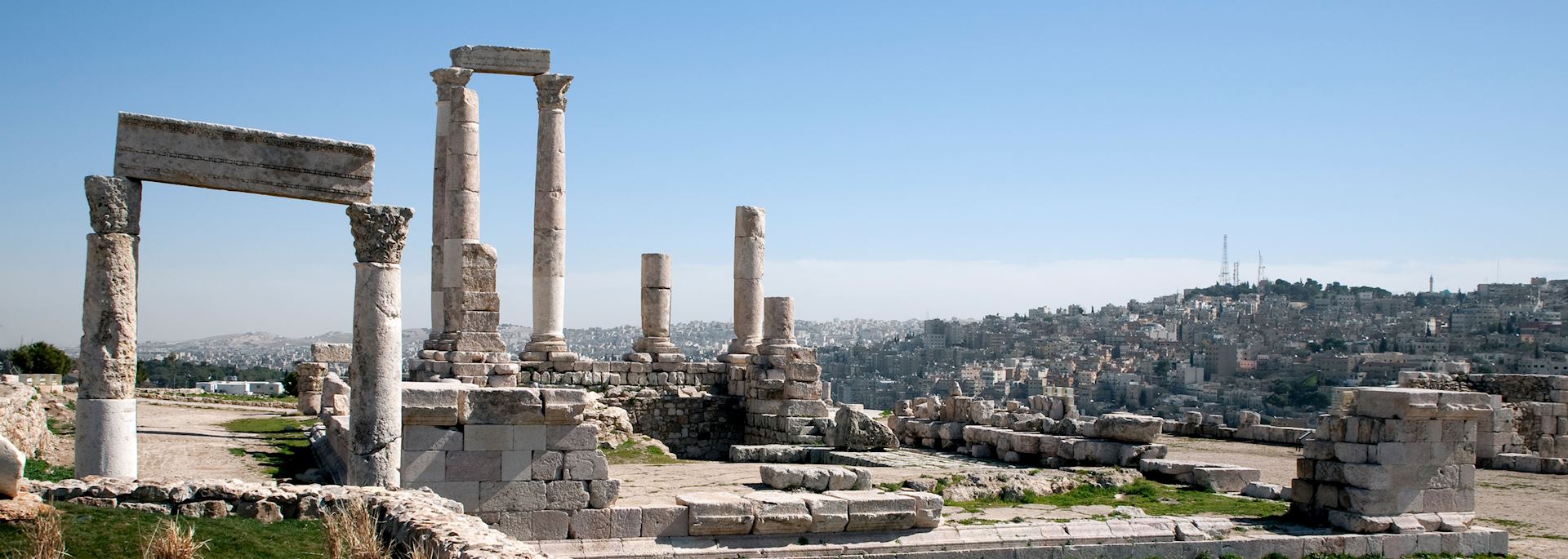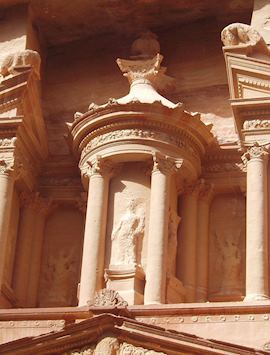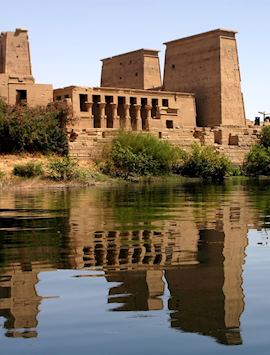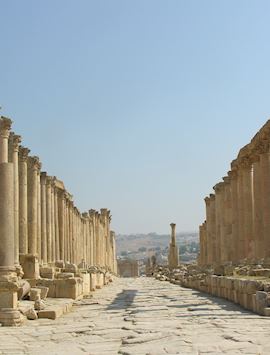By Jordan specialist Paula
If you followed the example of most visitors to Amman, you’d land late at night then wake up early the next day to head to Petra. But, if you linger for a day or two, you’ll discover that Jordan’s capital has much to offer. Though it looks thoroughly modern at first blush, Amman has ancient roots for you to explore, as well as a thriving culinary heritage.
It’s also a convenient base for visiting northern Jordan’s many other ancient and historical sites. Jerash is perhaps the most visited, but I also suggest a trip to the Roman-Ottoman ruins of Umm Qais and the Crusader-repelling Ajloun Castle, as well as the Hellenistic ruins at Iraq Al Amir.
What to see and do in Amman
Street-food tour
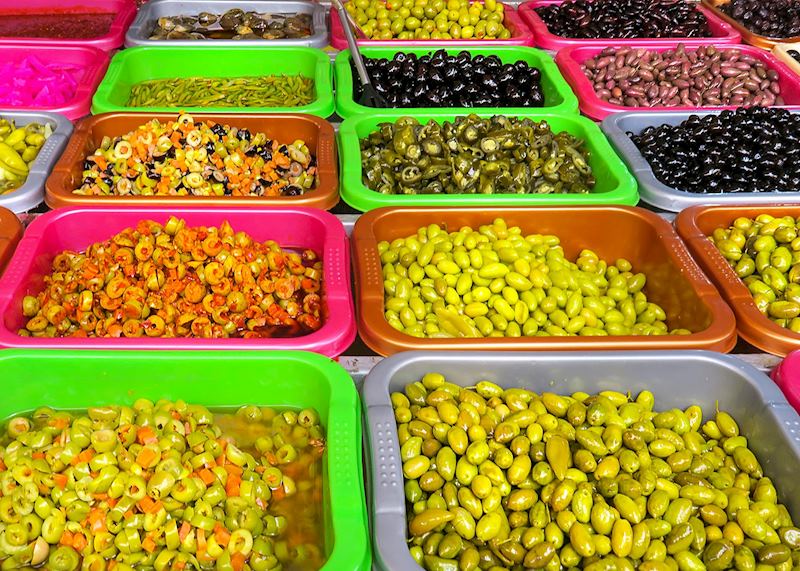
Jordan doesn’t share Morocco’s reputation as a Middle East culinary destination, but last spring I took a walking street-food tour of Amman with a guide and discovered there’s some delicious food to be found if you know where to look.
Bread is a staple in the local cuisine, so we began at a bakery. Of all the different sorts available, I’m fondest of tabun (or laffa), a lightly leavened flatbread. The baker shapes the dough by spinning it and then deftly slaps the pale round onto the interior of a cone-shaped wood-fired clay oven.
Stuck to the soot-blackened wall, the dough cooks quickly, leaving one side blistered and deeply browned in spots. The resulting bread is slightly charred and chewy, with a singular texture I’ve never found elsewhere.
We continued on to other small shops and stalls, picking up a cup of cold sugar cane juice or snacking on manakish (a fluffy bread topped with cheese or meat). We also joined a long queue that snaked down an alley to visit Habibah Sweets, a local institution to sample kanafeh, the national Jordanian dessert. The crispy semolina top — drenched in sweet rose syrup and sprinkled with chopped pistachios — hid a mild cheese underneath.
The grand finale was Hashem, an unassuming restaurant between two shops that boasts a star-studded clientele, including the king. There are no menus here and instead you enjoy a parade of typical Jordanian specialties. I ate tabbouleh, moutabel (a dish similar to baba ganoush), ful medames (mashed fava beans and olive oil), hummus and fattet hummus (a layered creation of crunchy grilled flatbread, creamy tahini sauce and hummus topped with pine nuts, olive oil, parsley and cumin).
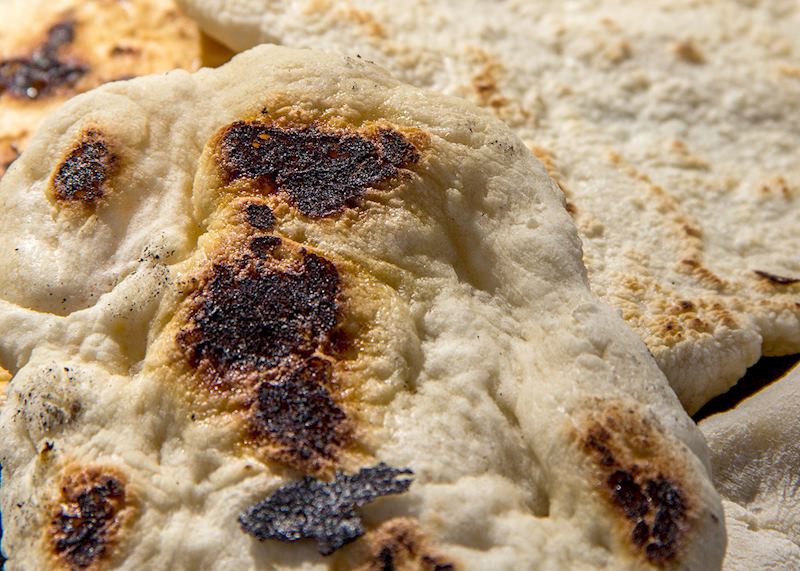
Cooking class at Beit Sitti
A similar menu was on offer at a cooking class called Beit Sitti. Translated as ‘Grandmother’s Kitchen’, the lesson was started by a young chef named Maria to keep her family’s culinary traditions alive.
You take the class in Maria’s grandmother’s kitchen, a high-ceilinged room where the walls are hung with painted dishes and copper-bottom pots. It’s located in a small family home in Jabal Al Weibdeh, one of the oldest areas in Amman.
Maria’s gentle direction and authentic recipes combine with the convivial atmosphere of working with your classmates to make it a pleasant way to spend an afternoon. In my class, we all assembled a classic, four-course meal using local, seasonal vegetables.
My share of the duties included making mujadara. The dish combines lentils, rice and onions, slowly cooked until they are sticky-soft and a sweet, deep golden brown. Afterwards, we all sat down to share the feast we’d made.
Ancient Amman
Though its streets and architecture are mostly modern, Amman’s roots stretch back to antiquity. The city was the capital of the Ammonites in the 13th century BC, later conquered by the Egyptians, Nabataeans and then Romans.
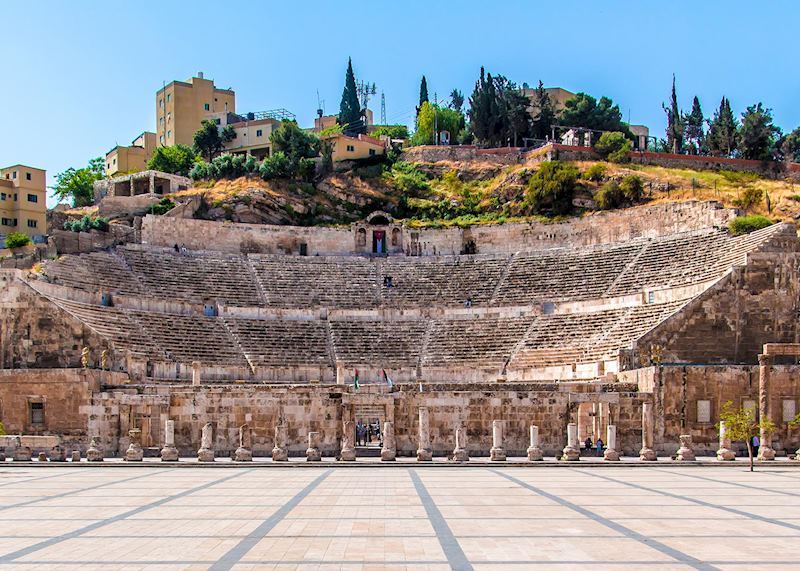
The march of time and several major earthquakes obliterated much of this history, but some is still preserved in the area known as Philadelphia (the city’s name during the rule of Ptolemy II Philadelphus).
The most impressive site in Philadelphia is the massive symmetrical Roman theater. Carved into a north-facing hillside, its current state is the result of a loving (if slightly inaccurate) restoration rather than remarkable preservation. For me at least, that knowledge doesn’t lessen the effect, particularly in the early morning when the soft light illuminates the ranks of curved seats rising up in three tiers.
Big enough to hold 6,000 spectators, the theater was the venue of entertainments then and now — you can often watch plays and concerts here in the summer months.
At the very top, there’s a small shrine that once held a statue of Athena, the theater’s patron goddess. For a look at some of the archaeology and items uncovered during the restoration, visit either of the two museums that are just off the stage. The nearby odeon and nymphaeum were built about the same time as the theater.
Overlooking the theater, the Citadel is an ancient walled fortress that has occupied a high hill since at least the Bronze Age. I was particularly taken with the three still-standing pillars that once marked the Temple of Hercules, erected during the reign of Roman Emperor Marcus Aurelius.
The pillars stand next to three massive and well-manicured fingers, the only remains of a statue of the temple’s namesake demigod — experts estimate that it once stood more than 12 m (39 ft) tall.
At the northwest corner of the fortress, the Islamic Palace is a complex of buildings built in the 8th century. The entrance hall for the main building follows a Greek-cross plan, hinting at the Byzantine church that’s thought to be underneath.
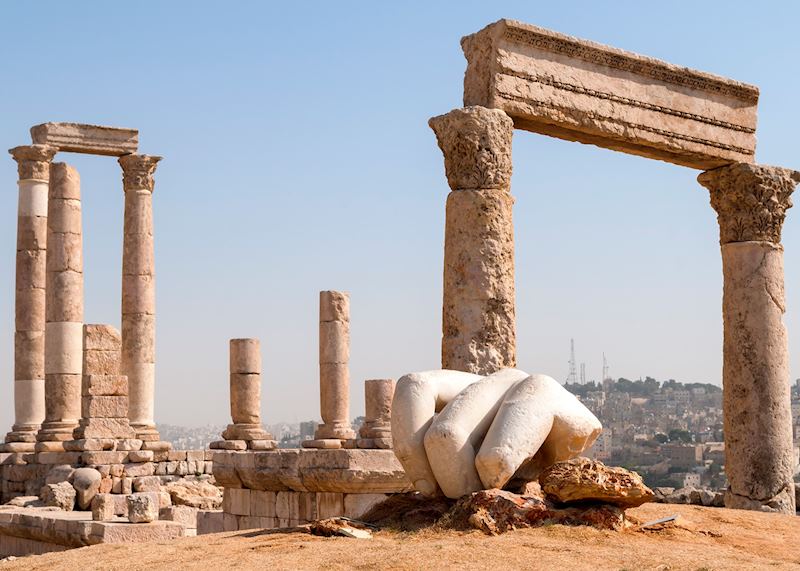
The Jordan Museum
In my opinion, one of the best museums in the Middle East, the Jordan Museum is a low, sleekly modern building near the city hall. Inside, you can explore a well-curated glimpse into the vast sweep of Jordan’s long history, from the Paleolithic Age through to the modern era.
The oldest known human statues are on display here — eerily blank-faced plaster figures that stare back at you with wide, unblinking eyes drawn in bold black lines. Dating back about 9,500 years, they were found in Ain Ghazal, a Neolithic village outside the city.
The Petra exhibition offers a good introduction not only to the ancient city but also to the Nabataeans who created it. You can see art and items from the site, as well as wall-length photographs to whet your appetite.
Jordan’s share of the Dead Sea Scrolls also resides here. Written in Hebrew, Nabataean, Greek and Aramaic, the ancient fragments of Jewish texts almost seem to resonate with their great age — some date back more than 2,500 years. This is also where you can see the Copper Scroll, the only portion of the cache written on metal.
What to see and do outside Amman
Jerash
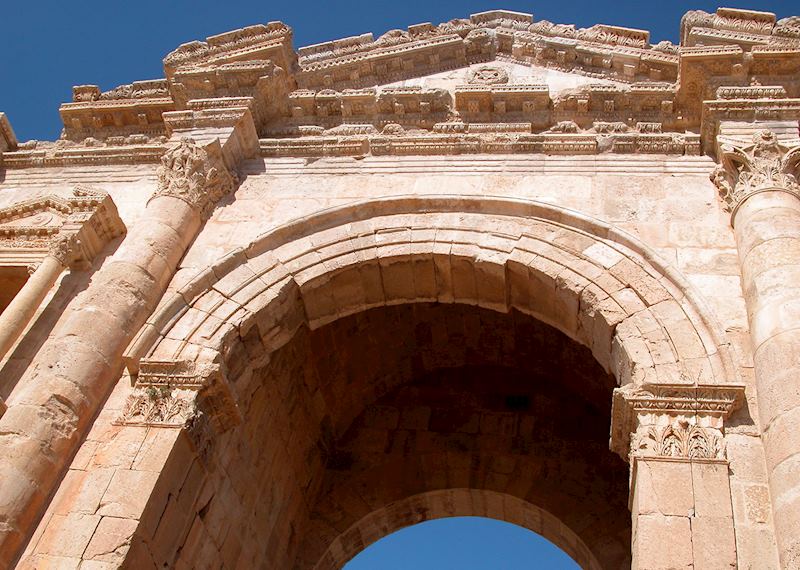
The first time I saw the whole of Jerash laid out in front of me, I was struck by just how well preserved the city remains. In the sprawling Greco-Roman ruins, many streets are largely intact and the buildings are easy to discern among the rubble.
An hour north of Amman, Jerash has been inhabited since Neolithic times, but it reached its height as a part of the Decapolis. This Byzantine trading network was a loose confederation of ten city-states that were dependent on the Roman Empire.
I suggest starting your visit early in the day, before the temperatures rise and the crowds arrive. Entering the ancient city through the towering gateways of Hadrian’s Arch, the first thing you see is the Roman-straight main road, paved with slightly irregular slabs. Two rows of columns march down the sides, some still topped by decorative capitals or a lintel.
One of the city’s highlights is the Temple of Artemis, the heart of worship for the city’s patron goddess. The portico boasts 11 intact columns (of an original 12). Inside, you can still see scorch marks left from the 12th century, when a Damascus noble converted the temple into a fort and the king of Jerusalem captured and burned it.
Umm Qais
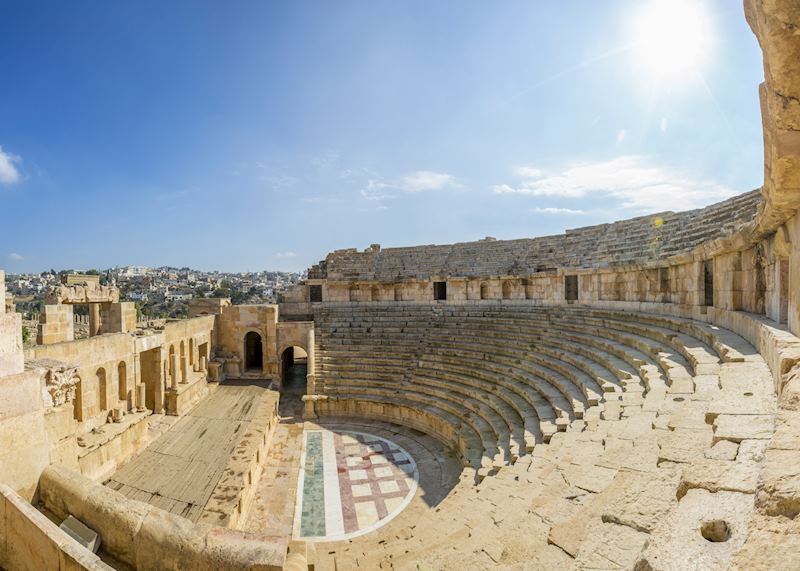
Another hour north, Umm Qais was also part of the Decapolis league. Today, you can see the Roman-era ruins standing next to abandoned Ottoman buildings.
Many of the Roman remnants, including the half-circle of the amphitheater, are built out of volcanic basalt. Even though weathered by time and dulled by dust, the black stone makes a striking effect. There’s a basilica courtyard dotted with sinister-seeming black sarcophagi made from the same material.
Elsewhere, some of the dark columns still sport capitals, and I gaped at the skill of the builders — the curves and tendrils of the acanthus leaves are still preserved in sharp detail.
The soaring, clean Roman construction, most of it built without mortar, stands in stark contrast to the blocky, heavily mortared Ottoman-era buildings. This is also where you can find some of the region’s best views. The city perches on a ridge, catching the Sea of Galilee, the Golan Heights and the River Jordan in its sweeping vistas.
Ajloun Castle
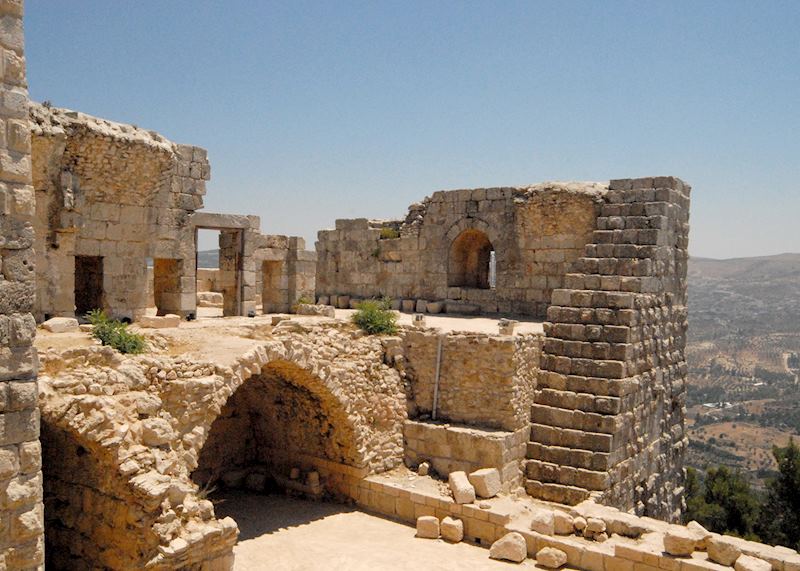
An hour south of Umm Qais and 20 minutes west of Jerash, Ajloun is lorded over by a 12th-century castle perched on a hill. The fortress dates to the Crusades, put up by the Islamic governors under Saladin as a base to repel the invading Christian armies.
The once-stern face of the castle is crumbling at the edges, the result of earthquakes and centuries of wear, but the buff stone façade still dominates the scrubby landscape thanks to its lofty position. The high vantage point once made the fort strategically important for the military — today, it offers you panoramic views of the Jordan Valley.
Ajloun is also home to a forest reserve, filled with low, dusty-leafed trees — small evergreen oaks, and wild strawberry, pistachio and carob trees. I particularly recommend hikes here in April and May, when the scrubland is painted in broad swathes of bright wildflowers, including scarlet poppies and clusters of the inky-purple black iris (Jordan’s national flower).
Iraq Al Amir and Qasr Al Abad
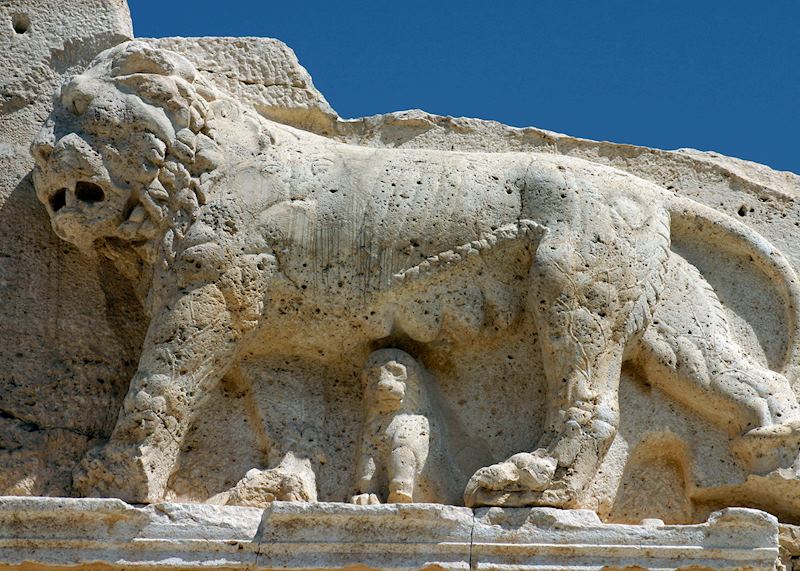
About 45 minutes west of Amman, the dun sand of the high desert plateau suddenly spills down into a green wadi, where you’ll find the village of Iraq Al Amir. This corner of the country doesn’t attract much attention, but it’s home to a rare example of pre-Roman construction.
Qasr Al Abad translates to the ‘Castle of the Slave’, offering a hint of the unusual history hidden behind the gap-toothed walls of the ruin. The legends and scholarship here are conflicting, and Qasr Al Abad might be a Jewish temple, a palace or an opulent villa intended to woo a nobleman’s daughter.
Regardless of the story, you’ll gaze at an impressive monument. Look for the animal carvings on the exterior wall, including a lion and a panther that once spouted water.
You can visit all of these sites on a one-day guided tour from Amman.
Read more about trips to Jordan
Start thinking about your experience. These itineraries are simply suggestions for how you could enjoy some of the same experiences as our specialists. They're just for inspiration, because your trip will be created around your particular tastes.
View All Tours in Jordan
